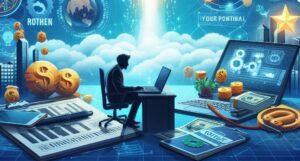The rise of Non-Fungible Tokens (NFTs) has sparked a digital revolution, transforming how we perceive, create, and manage assets in the digital world. What began as a niche market for digital art and collectibles has rapidly expanded into a broader ecosystem encompassing music, real estate, virtual goods, and more.
As NFTs continue to gain traction, businesses specializing in Digital Asset Management (DAM) are increasingly integrating NFTs into their operations, unlocking new opportunities for ownership, monetization, and value creation.
Read More: Elderly Care Tech Solutions: Transforming Senior Care for a Better Future
This article explores the intersection of NFTs and Digital Asset Management, highlighting the implications for businesses, creators, and consumers.
Understanding NFTs: A New Paradigm in Digital Ownership
To appreciate the impact of NFTs on Digital Asset Management, it’s essential to understand what NFTs are and why they matter. NFTs are unique digital assets that represent ownership of a specific item or piece of content, such as a piece of art, a song, a video, or even a tweet.
Unlike cryptocurrencies like Bitcoin or Ethereum, which are fungible and can be exchanged on a one-to-one basis, NFTs are non-fungible, meaning each one is distinct and cannot be replaced by another token.
NFTs are typically built on blockchain technology, which provides a decentralized and transparent way to verify ownership and provenance. This means that when someone buys an NFT, they are purchasing a verifiable digital certificate of ownership, which is recorded on the blockchain.
This certificate can be transferred, sold, or traded, giving the owner control over the digital asset in a way that was previously impossible in the online world.
The NFT Boom: From Art to Utility
The initial surge of interest in NFTs was driven largely by digital art and collectibles. High-profile sales, such as Beeple’s “Everydays: The First 5000 Days,” which sold for $69.3 million at auction, brought NFTs into the mainstream and demonstrated their potential as a new form of digital ownership. However, the utility of NFTs extends far beyond art.
NFTs are now being used to tokenize a wide range of digital and physical assets, including music, real estate, virtual goods in video games, and even domain names. This tokenization allows for the creation of unique, verifiable digital assets that can be easily bought, sold, or traded on global marketplaces.
As a result, NFTs are not only changing how we perceive ownership in the digital world but are also opening up new avenues for monetization and value creation.
Digital Asset Management: The Evolution of Asset Control
Digital Asset Management (DAM) has long been a critical component of business operations, particularly for organizations that deal with large volumes of digital content, such as media companies, marketing agencies, and e-commerce platforms.
DAM systems provide a centralized repository for storing, organizing, and managing digital assets, such as images, videos, documents, and branding materials. These systems are designed to improve workflow efficiency, enhance collaboration, and ensure that assets are easily accessible and properly licensed.
As the digital landscape has evolved, so too has the role of DAM. Today, DAM systems are increasingly integrated with other technologies, such as artificial intelligence (AI) and machine learning, to provide more advanced features like automated tagging, content recommendations, and rights management.
However, the advent of NFTs presents a new frontier for DAM, offering novel ways to manage, monetize, and secure digital assets.
The Convergence of NFTs and DAM
The integration of NFTs with Digital Asset Management systems is creating exciting new possibilities for businesses and creators alike. Here are some of the key ways in which NFTs are transforming DAM:
1. Enhanced Ownership and Rights Management
One of the primary benefits of NFTs is their ability to provide verifiable proof of ownership and provenance. This is particularly valuable in industries like media and entertainment, where content ownership and licensing can be complex and difficult to manage.
By integrating NFTs into their DAM systems, businesses can create unique digital certificates for their assets, ensuring that ownership and rights are clearly defined and easily transferable.
For example, a music label could use NFTs to manage the rights to a song or album, allowing it to easily track who owns the rights and how they are being used. This not only simplifies the licensing process but also opens up new revenue streams, such as the ability to sell fractional ownership of a digital asset or create limited-edition releases.
2. Monetization and Revenue Generation
NFTs offer new opportunities for monetizing digital assets in ways that were previously unavailable. By tokenizing their content, businesses can create unique, limited-edition products that can be sold directly to consumers or auctioned off to the highest bidder.
This can be particularly lucrative in industries like art, fashion, and entertainment, where exclusivity and scarcity are highly valued.
For instance, a fashion brand could create an NFT collection of virtual clothing items, each one unique and only available in limited quantities. These digital items could be sold to consumers as part of a broader digital fashion experience, generating additional revenue streams beyond traditional physical products.
Similarly, a media company could create NFTs for exclusive behind-the-scenes content or early access to new releases, offering fans a unique way to engage with their favorite brands.
3. Improved Security and Anti-Piracy Measures
The decentralized nature of blockchain technology provides inherent security benefits that can be leveraged by DAM systems. By tokenizing digital assets as NFTs, businesses can protect their content from unauthorized use and piracy. Each NFT contains a unique identifier that is recorded on the blockchain, making it virtually impossible to duplicate or tamper with.
This enhanced security is particularly important in industries like publishing and entertainment, where digital piracy is a significant concern. By integrating NFTs with their DAM systems, businesses can ensure that their assets are secure and that only authorized users have access to them.
4. Interoperability and Cross-Platform Integration
Another advantage of NFTs is their ability to be easily transferred and traded across different platforms and ecosystems. This interoperability makes it possible for businesses to integrate their NFTs with a wide range of digital platforms, such as online marketplaces, social media networks, and virtual worlds.
For example, a gaming company could create NFTs for in-game items that can be used across multiple games or platforms. This not only enhances the value of the digital asset but also creates new opportunities for cross-promotion and collaboration. Similarly, a media company could integrate its NFTs with social media platforms, allowing fans to showcase their digital collectibles and interact with other users.
5. Long-Term Value and Collectibility
The unique nature of NFTs makes them particularly well-suited for creating collectible digital assets that can appreciate in value over time. By leveraging the power of scarcity and exclusivity, businesses can create digital products that are not only desirable but also have the potential to become valuable investments.
This has significant implications for industries like art and entertainment, where collectors and fans are always on the lookout for rare and valuable items. By integrating NFTs into their DAM systems, businesses can create digital assets that have long-term value and appeal, creating a new market for digital collectibles.
Challenges and Considerations
While the integration of NFTs with Digital Asset Management systems offers many exciting opportunities, it also presents several challenges that businesses must navigate.
1. Environmental Impact
One of the most significant criticisms of NFTs is their environmental impact. The blockchain networks that support NFTs, such as Ethereum, require significant amounts of energy to operate, leading to concerns about their carbon footprint. As businesses increasingly adopt NFTs, they must consider the environmental implications and explore more sustainable alternatives, such as proof-of-stake (PoS) networks or carbon offset initiatives.
2. Regulatory and Legal Issues
The legal landscape surrounding NFTs is still evolving, and businesses must be aware of the potential regulatory challenges. Issues such as intellectual property rights, taxation, and consumer protection are all areas where regulations may vary by jurisdiction. As the market for NFTs continues to grow, businesses will need to stay informed about legal developments and ensure that their practices comply with relevant laws.
3. Market Volatility
The market for NFTs is still relatively young and can be highly volatile. Prices for NFTs can fluctuate significantly, and there is a risk that the market could experience a bubble or crash. Businesses entering the NFT space must be prepared for this volatility and develop strategies to mitigate potential risks.
4. User Experience and Accessibility
The process of buying, selling, and managing NFTs can be complex and confusing, particularly for those who are new to blockchain technology. To succeed in this space, businesses must focus on creating user-friendly platforms and tools that make it easy for consumers to engage with NFTs. This may include educational resources, intuitive interfaces, and customer support to help users navigate the NFT ecosystem.
The Future of NFTs and Digital Asset Management
The integration of NFTs with Digital Asset Management systems is still in its early stages, but the potential for innovation is immense. As businesses continue to explore the possibilities of NFTs, we can expect to see new use cases, business models, and revenue streams emerge.
In the future, NFTs could become a standard component of Digital Asset Management, offering businesses a powerful tool for managing ownership, rights, and monetization in the digital world. As the technology matures and becomes more widely adopted, the line between digital and physical assets will continue to blur, creating new opportunities for value creation and exchange.
For businesses, the key to success in this evolving landscape will be staying ahead of the curve, understanding the unique opportunities that NFTs offer, and developing strategies that leverage their full potential. Whether you’re a creator, a brand, or a digital asset manager, now is the time to explore the possibilities of NFTs and position yourself for success in the digital economy of the future.
Conclusion
NFTs are transforming the way we think about digital ownership, and their integration with Digital Asset Management systems is opening up new possibilities for businesses and creators. From enhanced ownership and rights management to new monetization opportunities and improved security, NFTs offer a powerful tool for managing digital assets in the modern world.








